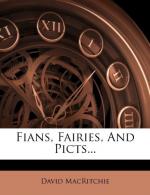In regarding the Fians as a race of dwarfs, I do not overlook the fact that they are also spoken of as “giants.” But to assume them to have been of gigantic stature is both totally at variance with the bulk of the evidence regarding them, and at variance with the fact that the word “giant” has very frequently been used to denote a savage, or a cave-dweller.[41] No more appropriate illustration of this can be found than the local tradition that a certain artificially hollowed rock in the island of Hoy, Orkney, was the abode of “a giant and his wife.” Now, this same “giant” is also remembered as a “dwarf,” and the largest cell in his dwelling is only 5 feet 8 inches long. Similarly, there is in Iceland a certain Troellakyrkia (literally “the dwarfs’ church”) which is translated “the giants’ church."[42] For these reasons, then, I do not regard any reference to the Fians as “giants” as indicating that they were of tall stature; although I see no objection to the assumption that they were savages and cave-dwellers.
Fians, then, are closely connected with the “little people” called “Fairies.” The connection between Fians and Picts is equally well marked.
Regarding them historically, Dr. Skene identifies the Fians with one or other of two historical races believed to have occupied Ireland before the coming of the Gaels. These two races are known in Irish story as the Tuatha De and the Cruithne.[43] Now, the Tuatha De are the Fairies of Ireland.[44] Therefore, according to Dr. Skene, the Fians were either Fairies or Cruithne. Now, Cruithne is simply a Gaelic name for the Picts. Consequently, the Fians were either Fairies or Picts—according to Dr. Skene. In one traditional story, already referred to, the Fians seem to be unhesitatingly regarded as Picts. This story, obtained in Sutherlandshire, tells how a certain king lived for a year with a banshee, or fairy woman,[45] by whom he had a son. When this son grew up he went to the country of the Fians,[46] and there he entered into the service of their king, who was no other than the celebrated Oisin. The Gaelic narrator calls him “Oisin, Righ na Feinne,” that is, “Ossian, King of the Fians”; but the collector of the story,[47] who had no doubt obtained the translation on the spot, renders Righ




